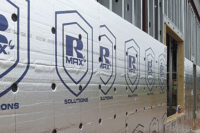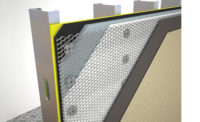A common misconception is that cutting corners on the job site somehow helps reduce costs. This practice is called many things, but perhaps is most commonly referred to as “value” engineering. I’ll concede that upfront and short-term cost savings may be realized when inferior materials are substituted, but at whose long term expense? The building owner, the industry, and perhaps your reputation!
Lessons Learned
Those who have been in the industry long enough know full well what can happen when corners are cut on the exterior building envelope. Remember that little EIFS issue back in the 80’s and 90’s? Failures were rarely due to faulty material, rather they were a result from trying to cut corners: foam direct applied to plywood sheathing with no weather barrier, inadequate or no flashing used around doors and windows, lack of proper training, etc. Though the industry survived it was badly bruised and according to some it is still rebuilding its reputation. Manufacturers, distributors, and contractors collectively learned from mistakes, and the EIFS industry is now roaring back due to continuous insulation requirements in the energy codes.
Current Challenge
Continuous insulation and the ever increasing demand for energy efficiency in the codes have brought challenges and opportunity to our industry. Being from the “younger” generation, I appreciate the strides we, as a nation, are making towards energy conservation. Investments we make in constructing energy-efficient buildings will benefit our children for generations to come. New construction methods and building envelope configurations that incorporate continuous insulation require you to stop and think twice about “value engineering.” The consequences of not getting it right can be disastrous, as we learned from decades past.
Consider the three main cost categories for a wall assembly which, depending on the wall type, may be near evenly split: material, labor, and overhead including project management. Material needs to last the lifetime of the building. “Value” engineered material substitutions aren’t necessarily good for the industry or your bottom line: it jeopardizes the performance of the building and your reputation while adding long term costs to the building owner. Don’t be penny wise and pound foolishly on material like insulation that needs to last the lifetime of the building. Rather, look for bigger savings by cutting your labor costs! Keep reading for some tangible examples.
The Solution
Labor cost savings can be achieved by investing in proper training, labor saving tools, and through labor efficient methods of installation. Here are a few specific examples to help illustrate tangible cost savings for installing continuous insulation without cutting corners or jeopardizing long term building envelope performance:
Washers with pre-spotting prongs for on-the-wall screw assembly: most types of rigid continuous insulation on the market require mechanical attachment with a washer and fastener. Whether EPS foam for EIFS, foil faced polyiso directly attached to steel studs, or XPS insulation over gypsum sheathing, tested washers and screws will be specified to ensure that air and moisture does not leak through the penetrations of the air barrier assembly. A typical 50,000 square-foot building may require over 40,000 fasteners for proper attachment. Think of how much time is wasted on the job site to hand assemble that many screws. The labor saving solution: use air-sealing washers with prongs that can be easily pre-spotted on the insulation for rapid on-the-wall screw assembly. You benefit by avoiding the cost of expensive pre-assembled screws and washers while simultaneously reducing your labor costs.
Labor saving auto-feed screw guns and tools: for even greater savings, invest in proper labor saving tools and adaptors. Auto-feed screw guns with nose adaptors to fit the washers in the example above can speed up labor by over four times while simultaneously helping prevent overdrive of the washers through the insulation and air barrier. Investments in proper labor saving tools will add profit to your bottom line while ensuring long term performance of the insulation and air barrier.
Insulation Cutting Blades
What happens when you score and snap rigid insulation? You are left with an edge that is ragged and out of square. When installed, the ragged edges leave gaps and cracks which are difficult to seal properly against air and moisture. Any labor savings achieved by quickly scoring and snapping the rigid insulation are lost when you factor in the labor to go back and seal the gaps and cracks (let alone the long term reduction in energy performance!) As a solution, invest in insulation cutting blades, which are designed to slice factory-edge quality cuts without dust or debris. Tighter board joints translate to better energy-efficiency, faster installation, and better adhesion of joint sealing tape or liquid applied flashings. Various blades can be used with circular saws, table saws, and reciprocating saws for easy labor savings.
Lath with integrated drainage for adhered masonry: stucco and stone veneer can serve many decades as a low-maintenance cladding if properly installed. Adhered masonry is porous and moisture will migrate through the lamina. It is important to install not only a proper weather resistive barrier to prevent moisture migration through the wall, but also to install a drainage plane to ensure adequate moisture management and ventilation. When installing adhered masonry over continuous insulation, drainage is especially important to prevent moisture from getting trapped between the layers. The traditional method of installation requires multiple layers to be built up (WRB and insulation, drainage plane, then lath attachment). Look for solutions that incorporate lath with an integrated drainage plane for faster installation, increased profit to your bottom line, and ensured long term performance for the building owner.
Brick-ties paired with air sealing washers for insulation attachment: brick veneer cavity walls are often built with a layer of continuous rigid insulation that doubles as the air barrier. To maintain air barrier performance the insulation must be permanently secured with corrosion resistant screws and air sealing washers. The fastener spacing “rule of thumb” is every 16 inches by 16 inches in the field and every 12 inches around the perimeter of the board (including around doors and windows) to maintain the as tested air barrier performance. This spacing translates to around 28 fasteners per 4-foot by 8-foot sheet. The veneer ties add an additional 12-16 penetrations through each board. That is a lot of penetrations and thermal-shorts. Air sealing brick-tie washers have been developed for single barrel brick-ties combining two installation steps into one and greatly reducing the number of fasteners required. Reduced labor, reduced material, reduced thermal bridging and reduced penetrations of the air barrier translates to a better performing building for the owner and more profit for you.
In closing, you can cut costs without cutting corners and jeopardizing long term performance. Use tested materials of uncompromising quality from trusted manufacturers and invest in proper labor saving tools. This will help you achieve superior, long-term results for the building owner, industry, your reputation and bottom line.












